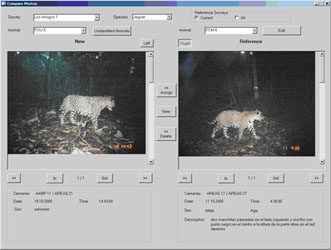Thank you to Mathias for organising an interesting group of people for our camera trap workshop and lunch time seminar, both were well attended by San Diego Zoo staff and other Californian researchers and students. The researchers covered a diverse range of interests and study areas from Red foxes in Nevada, Jaguars in Central America, the Channel Islands, Burrowing Owls in the US, Apes in Cameroon, Galapagos birds reintroductions, nest monitoring in the Cactus Rim, Condor Recovery Programs, Biodiversity research in Mongolia, Bears in Peru, human impacts in San Francisco, reptiles in Jamaica and a number of new and emerging projects in Costa Rica and elsewhere around the globe. It was an eclectic mix of people and subjects, all using camera trapping to carry out their research and monitoring.
The morning discussion focussed on ways to improve camera trap designs for wildlife research which led to a series of discussions about both camera and survey design. A re-emerging issue was the cost vs quality issue in camera models. There was common agreement that the product made by Reconyx was superior to other models but the cost was too prohibitive and as such people were buying cheaper brands so that they could deploy larger numbers in the field. Mathias is using Scoutguards and believes they are doing a pretty reasonable job in his research; he expects a failure rate of about 20% but regards them as consistent. There were a range of other cameras being used including Deercam, Trailmaster, Cuddeback and Bushnell Trophy Cams. Both Bushnell and Scoutguards were regularly deployed in tough country and the researchers felt the results were very good. The video quality of Scoutguards was considered to be very good by one of the researchers and a primary reason for choosing this model camera trap. We had a brief discussion about the new Acorn tri-sensor camera trap and one of the researchers will be letting us know what her thoughts are on this new camera trap; I understand another of our colleagues is also using them in Italy.
The key requirements for a good camera trap design according to this group was a small unit, fast trigger time, 3-5 rapid fire function, good image quality, long battery life, video and still and the ability to use any size SD card.
An interesting discussion emerged about the differences between baited and unbaited sites (passive vs active) on analysis and the potential bias this can introduce in some species. Some researchers reported that in their assessments lures and baits introduced a bias, in bear studies lures were found to initially attract bears but then they showed avoidance. The group were particularly interested in the effects of using a lure in occupancy analysis and Mathias was of the opinion that passive and active surveys can both work in this analysis. One thing was agreed – we need to undertake research on the effects of passive vs active stations and the effects this can have on detectability. I know that at least one of my host researchers has collected data on this subject but at this stage it is still unpublished, so contacting our colleague will be the first step towards resolving this question.
Mathias gave a seminar on his camera trap data base – Camera Base V1.4. This data base is an excellent platform for managing and analysing image data. At present he is aware of about 40 projects currently using his software and a new version, with some of the glitches resolved will be available early next year, time permitting. The software uses ACCESS as a back end and is designed to store single or paired camera data, which is neat. The software also enables analysis and comparisons between paired camera trap data to test for detection and allows image assessment that can in turn be used in pattern analysis for target species. The program has all the functionality of ACCESS in terms of queries, sorting and reporting etc and data can be exported to other formats if necessary. The data can also be analysed in CAPTURE and has a very nice Occupancy Modelling tool that removes the need for hand coding of data. A feature we are very excited about is the temporal activity pattern analysis function.

Copies of Mathias’ software can be downloaded from http://www.atrium-biodiversity.org/tools/camerabase and he is keen to get any feedback on how to improve the program.
We also listened to a short presentation by Mathias on occupancy modelling and other analysis techniques which raised some opinions about camera trap survey design and the implications of making sure that you have several years of data before attempting to use occupancy models. A case study example was presented on Peccaries showing how movement variations between seasons and years can influence the results of analysis.
In an un-planned session after the workshops had finished I was treated to a very interesting but quick presentation by Susan Townsend on her camera trapping research in Mongolia - a very impressive project with some sensational images of the truly unique wildlife of Mongolia….. envious !
I was very privileged to have met such a large number of researchers using cameras from so many different backgrounds and projects, I am very interested to see how the reptile, bird and crocodile research progresses. I established some great contacts at this meeting and I think many participants have established new links and developed new ideas based on the days’ deliberations. I was very encouraged to hear from many of the people in attendance, that they were supportive of the camera trap symposium being sponsored by the Australasian Wildlife Management Society in Australia next year. Moreover, that many people were keen to come to Australia or at least hook up on line through web based conferencing. I will provide updates on this Symposium in the next few months but keep the end of 2012 open for a few days of interesting discussion and some opportunities to travel around our great Country.














